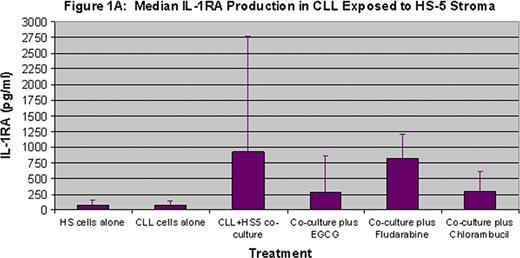Abstract
Abstract 3882
Nurturing of leukemic B-cells by the microenvironment appears to be an important mechanism of chemoresistance. Recently, several groups have shown that immune cytokines such as MIP-1a (CCL3) and MIP-1b (CCL4) are upregulated when CLL B-cells interact with stroma or nurse-like cells. It appears that stroma may nurture CLL B-cells by providing critical growth factors and signals enhancing survival. Disruption of these signals could be a strategy to overcome stromal cell mediated chemoresistance.
We cultured CLL B-cells alone or with human stromal cells (HS-5) and evaluated levels of immune cytokines in the media using multiplex cytokine arrays (Invitrogen). To explore the effect of different drugs on cytokine release, CLL B-cells were treated with sub-lethal doses of fludarabine (F) and chlorambucil (C) in co-culture with the stromal cell line HS-5 cells. Based on our previous observation that pharmacologically achievable doses of EGCG are able to overcome stromal rescue of CLL B-cells exposed to purine nucleoside analogues and alkylating agents (ASH 2010), we examined the effects of EGCG on stromal cell mediated cytokine release in co-cultures. In addition, plasma samples collected prior to and after 1 month of treatment from Rai stage 0-II CLL patients participating in a phase II trial of EGCG were used to explore whether there was a clinical correlation of the in vitro effects of EGCG.
Co-culture of CLL B-cells with HS-5 cells resulted in upregulation of multiple cytokines. In addition to the previously reported upregulation in MIP-1a and MIP-1b, increases in IL-1RA (5 fold) and MCP-1 (4 fold) were also observed. Upregulation of these cytokines in co-culture was largely contact dependent.
When CLL B-cells and HS5 cells were co-cultured with sub-lethal doses of F, modest reductions in the upregulation of IL-1RA (12%) and MCP-1 (18%) were observed compared to co-culture without drug exposure. Similar experiments using sub-lethal doses of C resulted in more substantial reductions in IL-1RA (68%) and MCP-1 (48%) upregulation. Interestingly, the effect of sub-lethal doses of EGCG was similar to C with respect to reducing upregulation of IL-1RA (69%) and greater than both F and C with respect to upregulation of MCP-1 (76%; Figures 1A and B).
To explore the potential clinical correlations of these in vitro observations, we assessed the effects of EGCG on plasma IL-1RA and MCP-1 levels in 42 CLL patients participating in a phase II trial evaluating the efficacy of EGCG (2000 mg BID). Of these 42 patients, 13 (31%) were Rai stage 0 and 29 (69%) Rai stage I-II at enrollment. As previously reported (Shanafelt, ASCO 2010), clinical activity was observed with 13 (31%) patients experiencing a sustained ≥20% reduction in absolute lymphocyte count (ALC) and 20 of 29 (69%) patients with palpable adenopathy experiencing at least a 50% reduction in the sum of nodal products with treatment. Median baseline plasma MCP-1 levels prior to treatment were 687 pg/ml and median IL-1RA levels were 468 pg/ml. At the cohort level, no change in median MCP-1 (p=0.21) or IL1-RA (p=0.95) levels were observed after 1 month of EGCG treatment. We next explored whether changes in the MCP-1 or IL1-RA levels of individual patients correlated with response. Although no correlation between reductions these cytokines and declines in ALC were observed, a significant association between reductions of both MCP-1 (Spearman coefficient: 0.51; p=0.02) and IL1-RA (Spearman co-efficient: 0.60; p=0.006) and reductions in lymphadenopathy was found suggesting EGCG effects on these cytokines may relate to clinical efficacy.
Co-culture of CLL B-cells with marrow stromal cells resulted in contact dependent up-regulation of multiple immune cytokines including IL-1Ra and MCP-1 which we speculate may partially facilitate stromal cell mediated chemoresistance. Several drugs, including EGCG appear to modulate this up-regulation. An association between changes in these cytokine levels and reductions in lymphadenopathy in a phase II trial of EGCG suggests that interrupting signaling by these cytokines may be a potential therapeutic target.
Kay:Biothera: Research Funding; Clegene: Research Funding; Cephalon: Research Funding; Genentech: Research Funding; Glaxo Smith Kline: Research Funding; Hospira: Research Funding; Novartis: Research Funding; Supergen: Research Funding; Calistoga: Membership on an entity's Board of Directors or advisory committees; Celgene: Membership on an entity's Board of Directors or advisory committees; Emergent Biosolutions (Formerly Trubion): Membership on an entity's Board of Directors or advisory committees. Shanafelt:Polyphenon E International: Research Funding.
Author notes
Asterisk with author names denotes non-ASH members.



This feature is available to Subscribers Only
Sign In or Create an Account Close Modal